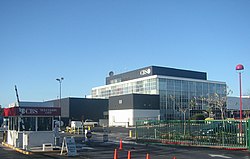Pereira & Luckman
(partnership with Charles Luckman)
1951
- Farmers & Stockmen's Bank, Phoenix, Arizona
- Gibraltar Savings and Loan Headquarters, 9111 Wilshire Boulevard, Beverly Hills, California
- Robinson's department store, Beverly Hills (demolished)
- Robinson's department store (now Target), 777 E. Colorado Blvd, Pasadena, California
1952
- Avco Research Center, Wilmington, Massachusetts
- Beverly Hills Hotel Addition, Beverly Hills
- Doheny Office Building, Beverly Hills
- Hilton Hotels headquarters, Beverly Hills
- Lear Industrial plant, Santa Monica
- Luke Air Force Base, Phoenix, Arizona
1953

- CBS Television City, Los Angeles
- Western Hydraulics plant, Van Nuys, California
1954

- Electronics and Radio Propagation Research Laboratories, Camp Pendleton, Oceanside, California
- KEYT Television Station, Santa Barbara, California
- KTTV Television Station, Los Angeles (At the time, KTTV was headquartered at Metromedia Square, which has been demolished. Pereira project details are uncertain.)
- National Bureau of Standards building, Boulder, Colorado
- Santa Rosa Hall – Dormitory, University of California, Santa Barbara
- United States Navy training facility, San Diego, California
- Wadsworth General Hospital, Veteran's Administration, Los Angeles
- Western Hydraulics Plant 2, Van Nuys, California
- William H. Block Department Store, Indianapolis
- WSBT Television Station, South Bend, Indiana
- Marineland of the Pacific, Rancho Palos Verdes, California [3]
1955
- Dormitories, Music and Science Buildings, Occidental College, Los Angeles
- Jet Production and Test Center, Palmdale, California
- Service Bureau Office Building, Los Angeles
1956

- Fallbrook Hospital, Fallbrook, California
- General Telephone Company Administration Building, Whittier, California
- Hunter Engineering plant, Riverside, California
- Prudential Tower, Boston (early designs)
- Southern California School of Theology, Claremont, California (now Claremont School of Theology)
- United States Air Force and Naval Bases, Cádiz, Spain
- Braniff International Airways, Operations and Maintenance Base, Dallas, Texas
1957
- First National Bank, Denver, Colorado
- Motion Picture Country House and Hospital, Woodland Hills, California
- Nellis Air Force Base buildings, Nevada
1958

- Beckman Corporation plant, Newport Beach, California
- Berlin Hilton, Berlin, Germany
- Bullock's Fashion Square, Santa Ana, California (partially demolished, now Westfield MainPlace) [4]
- Chrysler Sales & Service Training Center, Anaheim, California
- Convair Astronautics, San Diego, California
- Disneyland Hotel
- Firestone Tire company headquarters, Los Angeles
- Ford Aeronutronics, Newport Beach, California (demolished)
- General Atomic, La Jolla, California
- Grossmont Hospital, San Diego, California
- IBM headquarters, Los Angeles
- Los Angeles International Airport
- Physical Plant Building B, University of Southern California
- Robinson's department store, Palm Springs, California
- Signal Oil headquarters, Los Angeles
- Union Oil Center, Los Angeles (now Los Angeles Center Studios) [5]
- Valley Presbyterian Hospital, Van Nuys, California























